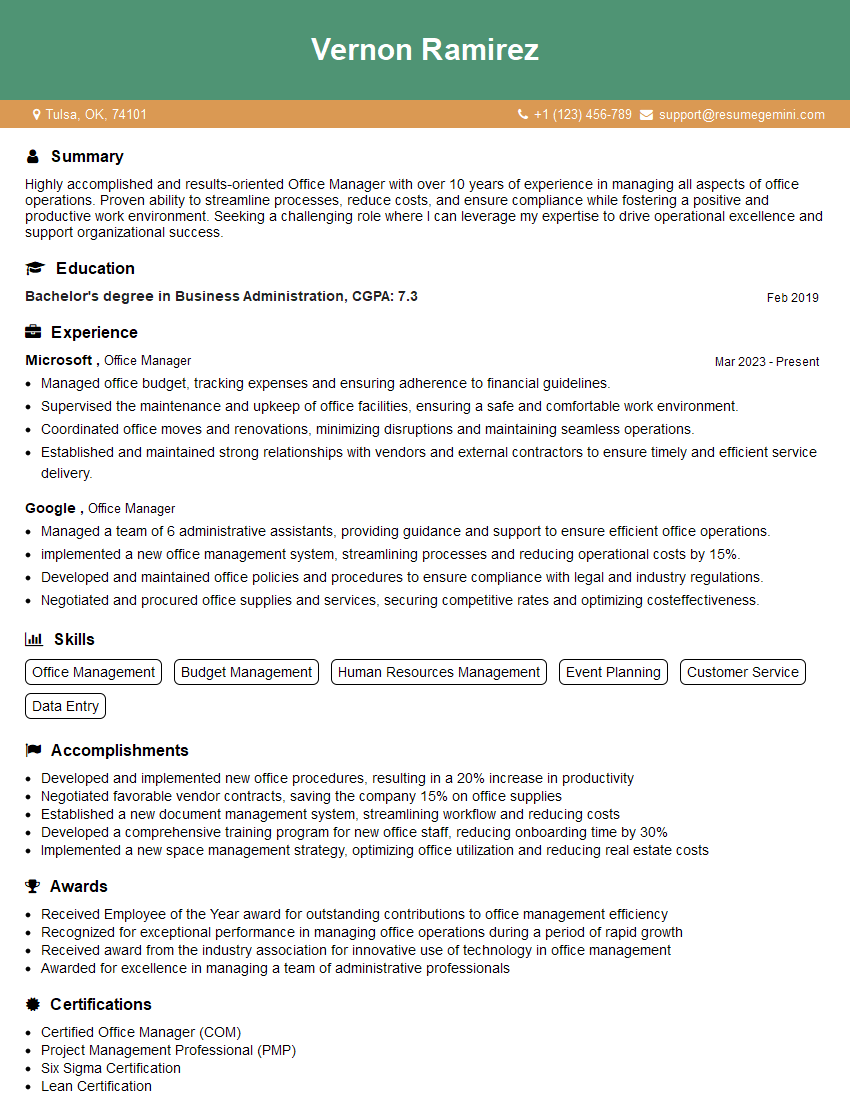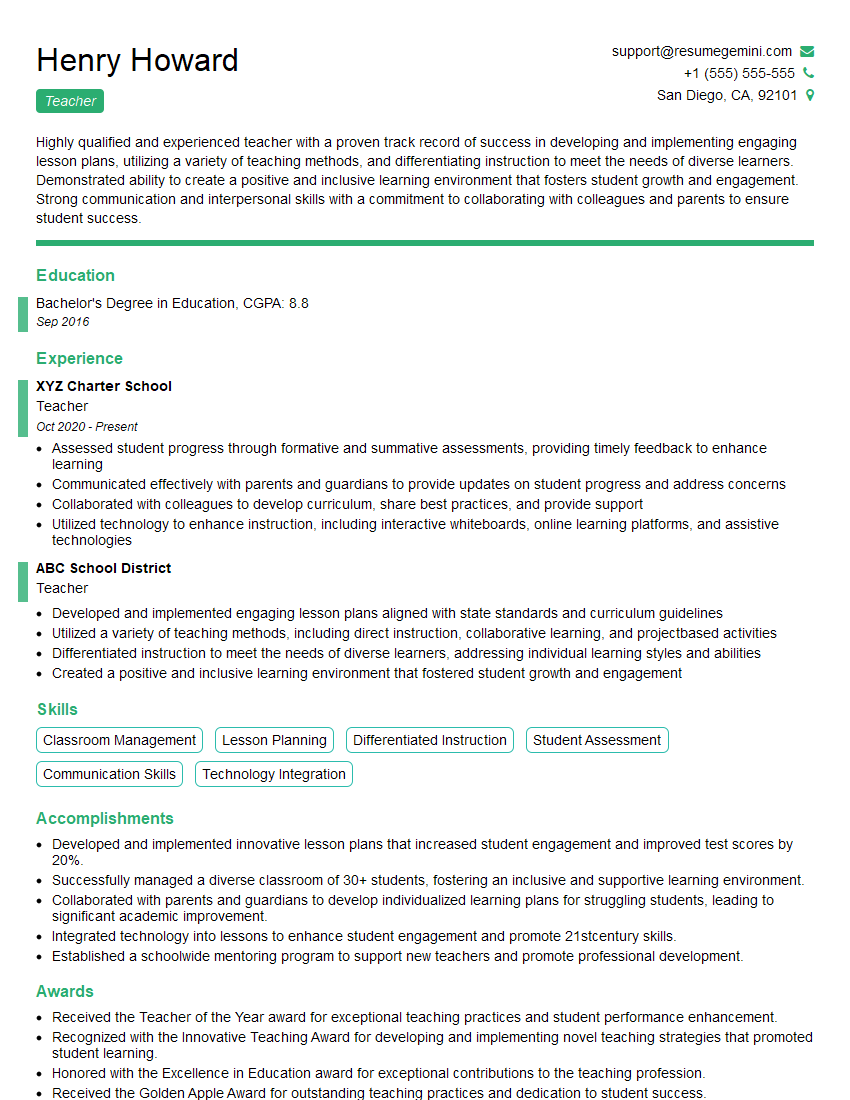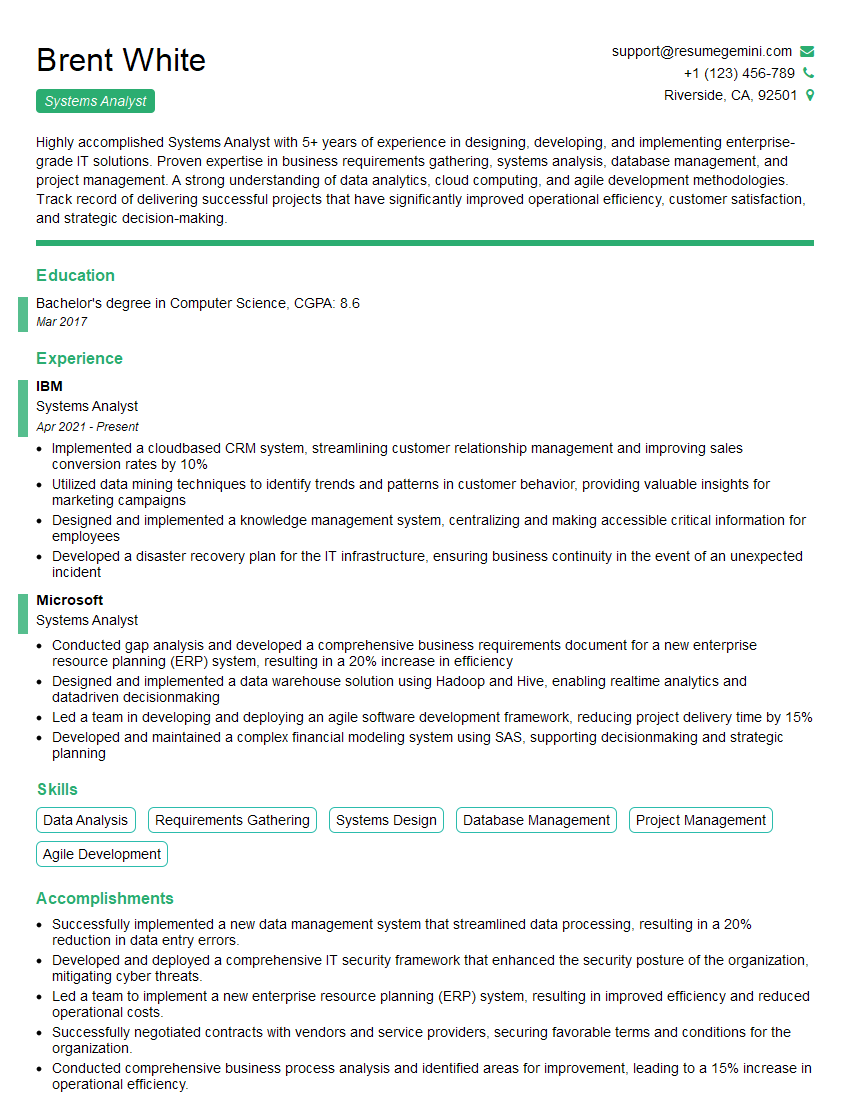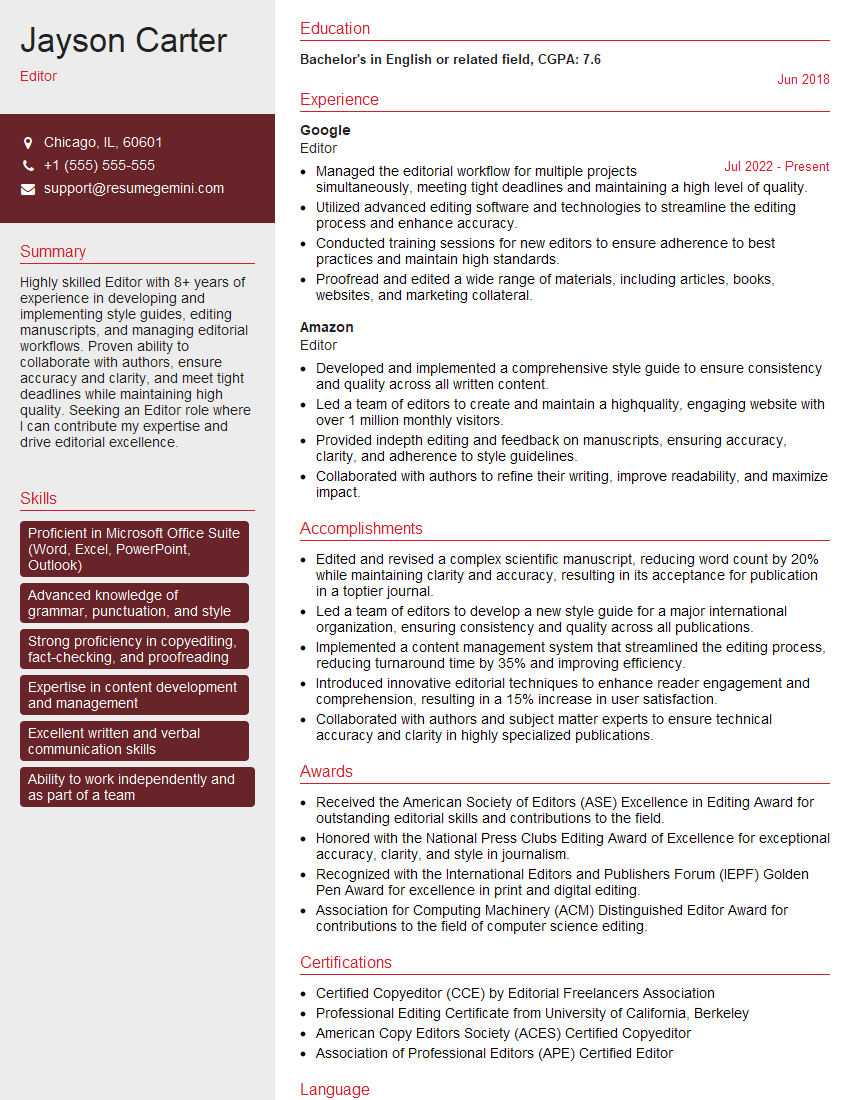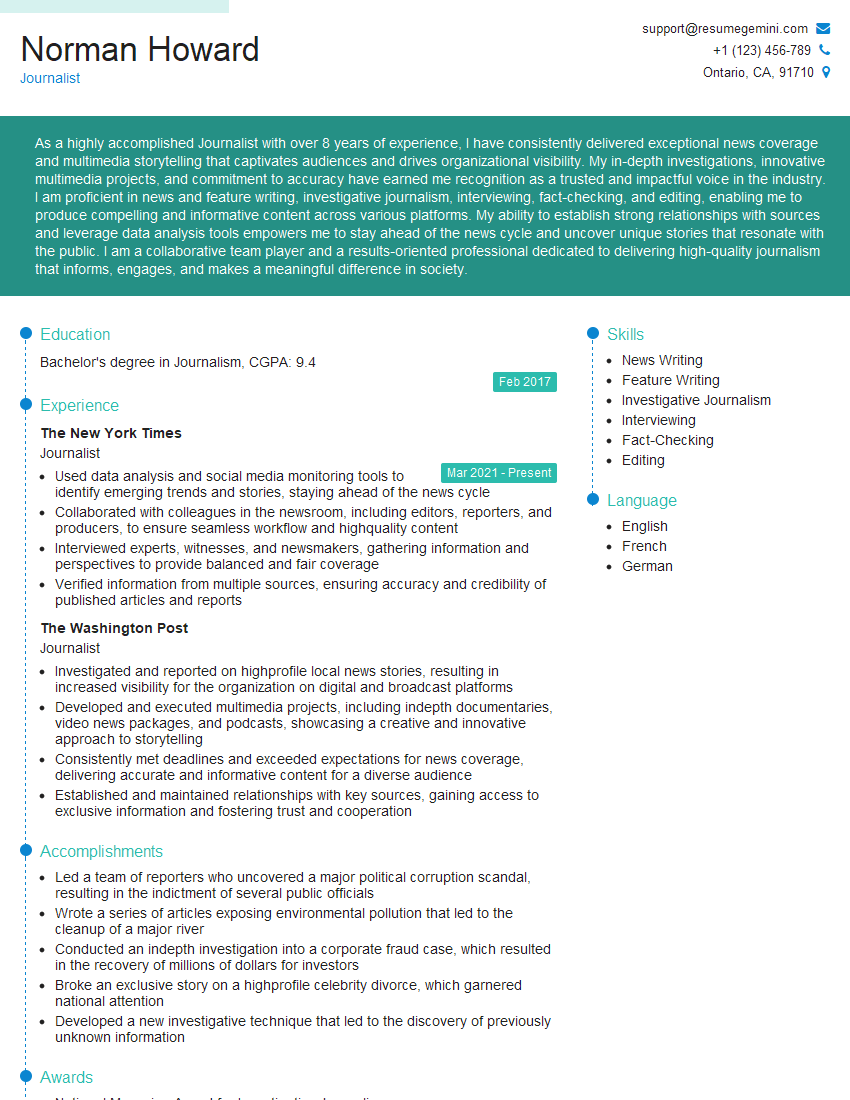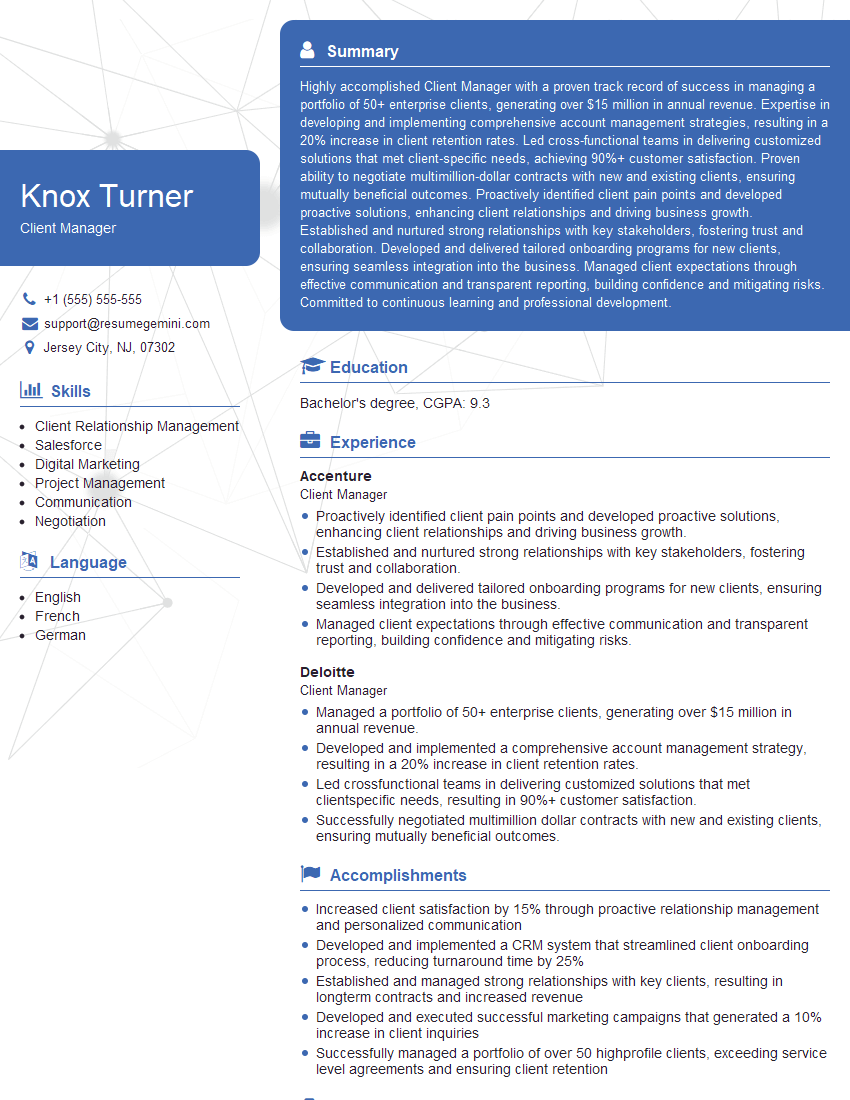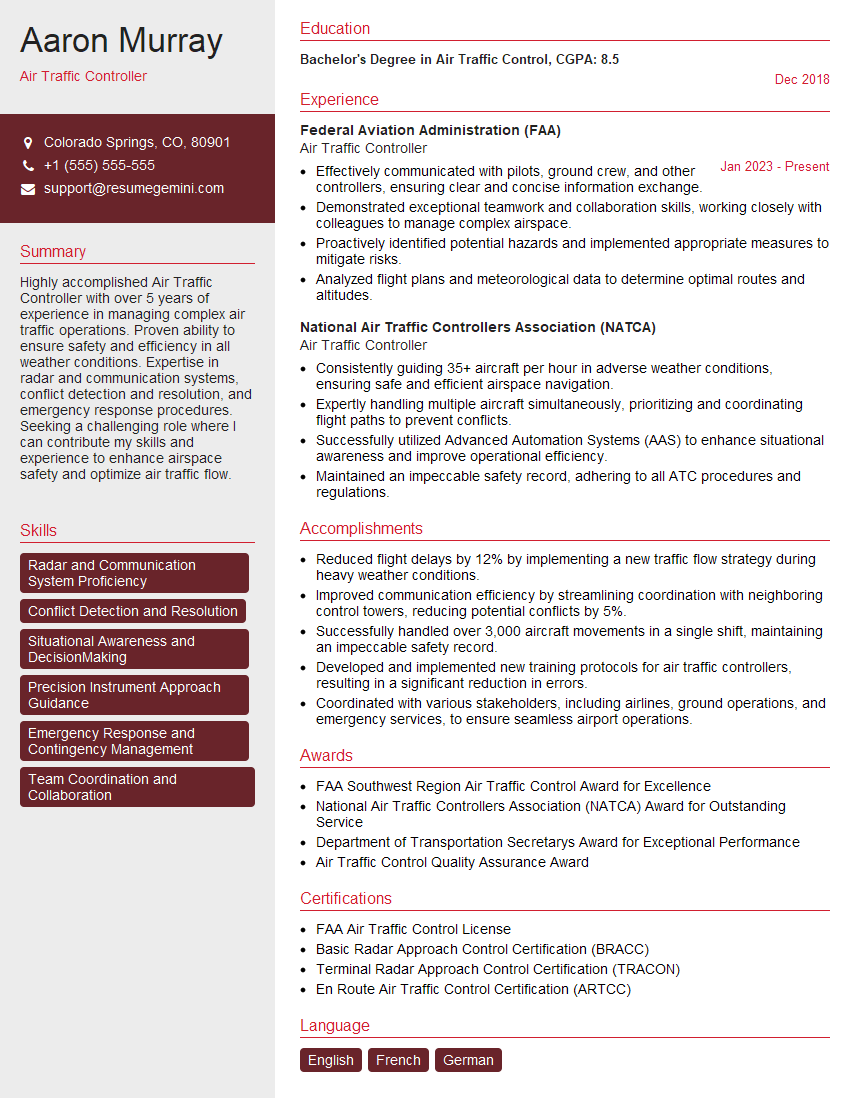Cracking a skill-specific interview, like one for Ability to Juggle Multiple Tasks, requires understanding the nuances of the role. In this blog, we present the questions you’re most likely to encounter, along with insights into how to answer them effectively. Let’s ensure you’re ready to make a strong impression.
Questions Asked in Ability to Juggle Multiple Tasks Interview
Q 1. Describe a situation where you had to manage multiple competing priorities. How did you prioritize?
Managing competing priorities is a core skill for any high-performing professional. It’s about making strategic choices to ensure the most important tasks are addressed effectively. In one instance, I was simultaneously leading a critical product launch, managing a team restructuring, and addressing an urgent client issue. My prioritization strategy involved using the Eisenhower Matrix (urgent/important). I mapped out all three projects, assigning each task to one of the four quadrants: Do, Decide, Delegate, Delete. The urgent client issue fell into ‘Do,’ the product launch milestones were largely ‘Do’ but with some ‘Decide’ elements regarding resource allocation, and the team restructuring was largely ‘Decide’ (planning and communication), with some delegation to my team leads. This helped me focus my immediate energy while laying the groundwork for more strategic long-term activities. I also regularly reviewed and adjusted this matrix to accommodate unforeseen changes and shifting priorities.
Q 2. How do you typically organize your workload to ensure efficient task completion?
My typical workload organization relies on a combination of tools and techniques. I use a project management software (like Asana or Trello) to list tasks, assign deadlines, and track progress visually. For each project, I break down large tasks into smaller, manageable sub-tasks. This prevents feeling overwhelmed and provides a sense of accomplishment as I check off each smaller goal. I also utilize time blocking, scheduling specific time slots for dedicated work on particular projects. This helps me avoid task-switching and maintain focus. Finally, I frequently review my schedule to identify potential bottlenecks and proactively adjust my plan as needed.
Q 3. What strategies do you use to avoid feeling overwhelmed when juggling multiple projects?
Avoiding overwhelm when juggling multiple projects requires a proactive approach to managing both workload and mental state. I use several strategies: Firstly, I practice mindfulness and short breaks throughout the day. Stepping away from my desk for even 5 minutes to stretch or meditate can significantly reduce stress. Secondly, I break down large projects into smaller, achievable goals. This provides a sense of accomplishment and momentum. Thirdly, I communicate openly with my team and manager about my workload. This allows for potential adjustments and collaboration, preventing me from feeling isolated in my challenges. Finally, I prioritize self-care activities outside of work, ensuring I have sufficient rest and opportunities for relaxation.
Q 4. How do you handle interruptions when working on a critical task?
Handling interruptions effectively while working on a critical task requires a mindful approach and clear communication. I usually employ strategies like designating specific ‘focus time’ blocks where I explicitly let colleagues know I’m unavailable for interruptions. If interrupted, I quickly assess the interruption’s urgency and either deal with it briefly (if it’s quick) or politely schedule a time to address it later. This requires clear boundaries and the ability to say ‘no’ gracefully when necessary. I also use noise-canceling headphones to minimize distractions.
Q 5. Describe your approach to time management when dealing with multiple deadlines.
Time management with multiple deadlines necessitates a structured approach. I begin by creating a master calendar outlining all deadlines. Then, I use a reverse-chronological approach, working backward from the most pressing deadline. This allows me to identify critical path activities (tasks that must be completed before others) and allocate time accordingly. I also incorporate buffer time into my schedule to account for unexpected delays and allow for flexibility. Regular review and adjustment of my schedule are crucial for staying on top of things.
Q 6. How do you delegate tasks effectively to maximize your productivity?
Effective delegation involves entrusting the right tasks to the right people. This begins with a thorough understanding of my team members’ skills and strengths. When delegating, I clearly communicate the task’s objective, expected outcome, and deadline. I provide the necessary resources and support, and I empower them to own the process. Regular check-ins ensure they’re on track and allow me to offer guidance as needed. I view delegation not as offloading work, but as a strategy for leveraging my team’s collective capabilities.
Q 7. How do you track your progress on multiple projects simultaneously?
Tracking progress on multiple projects simultaneously requires a robust system. I rely on project management software to monitor individual task completion rates, deadlines, and overall project milestones. I also use visual tools like Gantt charts to represent project timelines and dependencies. Regular progress reports (both self-generated and team-based) are vital for identifying potential roadblocks and making necessary course corrections. This ensures transparency, accountability, and proactive problem-solving.
Q 8. What tools or techniques do you employ to stay organized and manage your workload?
Effective task management is crucial for juggling multiple responsibilities. My approach relies on a combination of strategic tools and techniques. I leverage digital project management tools like Asana or Trello to visually organize tasks, deadlines, and dependencies. These tools allow me to create boards, lists, and cards to represent individual tasks, categorize them by project or priority, and track progress visually. This provides a clear overview of my workload and helps prevent anything from slipping through the cracks.
Beyond digital tools, I utilize time management strategies like the Pomodoro Technique, breaking down work into focused intervals with short breaks in between. This helps maintain concentration and prevents burnout when tackling multiple tasks simultaneously. I also maintain a detailed to-do list, often prioritized using methods like the Eisenhower Matrix (urgent/important), which helps me focus on the most critical items first.
- Example: For a complex project with multiple sub-tasks, I would break it down into smaller, manageable chunks in Asana, assigning deadlines to each. This makes the overall project less daunting and allows for better tracking of progress.
Q 9. Have you ever had to re-prioritize tasks due to unexpected changes? How did you handle it?
Unexpected changes are inevitable in any dynamic work environment. I recall a situation where a major client requested an urgent modification to a project midway through the implementation phase. This meant I had to re-prioritize tasks immediately. My response involved a structured approach:
- Assessment: I first analyzed the impact of the change on existing deadlines and dependencies.
- Communication: I immediately contacted the relevant stakeholders to clarify the client’s request and assess the scope of changes.
- Reprioritization: I used the Eisenhower Matrix to re-evaluate the urgency and importance of all tasks, placing the client’s urgent request at the top. This involved pushing back some less critical tasks, while negotiating new deadlines with stakeholders where necessary.
- Execution: I delegated where possible, focused on the most critical tasks, and ensured open communication throughout the process.
Through this structured approach, I successfully managed to deliver the client’s urgent request without significantly compromising the overall project timeline.
Q 10. Describe a time you successfully managed conflicting deadlines.
I once faced conflicting deadlines for two major projects – a website redesign and a marketing campaign launch. Both had tight deadlines, overlapping by a week. My strategy involved careful planning and resource allocation:
- Timeline Analysis: I carefully analyzed the tasks and timelines for both projects, identifying overlapping tasks and potential bottlenecks.
- Task Delegation: Where feasible, I delegated tasks to team members, ensuring clear communication and alignment on expectations.
- Time Blocking: I implemented strict time blocking, allocating specific time slots for each project based on priority and urgency. This ensured focused effort on each project during its designated time.
- Communication and Collaboration: I maintained transparent communication with all stakeholders, proactively addressing potential roadblocks and keeping everyone informed of progress.
By meticulously planning and utilizing my team effectively, both projects were launched successfully, and both deadlines were met. This success highlighted the value of proactive planning and effective communication in managing conflicting deadlines.
Q 11. How do you ensure accuracy and quality when working on multiple tasks at once?
Maintaining accuracy and quality when juggling multiple tasks requires a disciplined approach. I utilize several strategies:
- Detailed Documentation: I meticulously document every step of each task, including decisions, changes, and progress. This helps maintain clarity and reduces the risk of errors.
- Regular Checkpoints: I build in regular checkpoints to review my work for accuracy and identify any potential issues early. This allows for timely correction and prevents errors from compounding.
- Prioritization and Focus: I focus intensely on one task at a time before moving on to the next, ensuring thorough completion and quality control before switching contexts.
- Use of Templates and Checklists: For repetitive tasks, I utilize templates and checklists to ensure consistency and reduce the likelihood of omissions or mistakes.
By employing these methods, I consistently deliver high-quality results, even while working on multiple projects simultaneously.
Q 12. What’s your preferred method for communicating progress updates on multiple projects?
Consistent and clear communication is paramount when managing multiple projects. My preferred method is a combination of tools and techniques:
- Regular Project Status Meetings: I hold regular meetings with stakeholders, providing concise updates on progress, challenges, and upcoming milestones. These meetings are agenda-driven and focused on action items.
- Project Management Software: I use project management software to track progress visually and share updates with team members in real-time. This creates a centralized hub for information and fosters collaboration.
- Email Updates and Reports: For less frequent or less urgent updates, I send concise emails summarizing progress or milestones achieved. I ensure these emails are clear, concise, and tailored to the recipient.
This multi-faceted approach ensures that all stakeholders receive timely and relevant updates on the projects they are involved in, promoting transparency and efficient collaboration.
Q 13. How do you determine which tasks require immediate attention versus those that can wait?
Prioritizing tasks effectively is a key skill in juggling multiple responsibilities. I rely heavily on the Eisenhower Matrix (Urgent/Important) to categorize tasks and prioritize accordingly:
- Urgent and Important: These tasks require immediate attention and are addressed first. Examples include urgent client requests or critical deadlines.
- Important but Not Urgent: These tasks are important for long-term goals but can be scheduled for later. Examples include planning or strategic initiatives.
- Urgent but Not Important: These tasks are often distractions that can be delegated or eliminated if possible.
- Not Urgent and Not Important: These tasks should be avoided or eliminated completely as they don’t contribute significantly.
By consistently applying this framework, I ensure that my time and energy are focused on the most impactful tasks, improving overall efficiency and productivity.
Q 14. How do you measure your success in juggling multiple tasks?
Measuring success in juggling multiple tasks isn’t just about meeting deadlines; it’s about consistently delivering high-quality work while maintaining a healthy work-life balance. I measure my success using a multi-faceted approach:
- On-time and within-budget project delivery: This is a key indicator of effective task management and planning.
- Client/Stakeholder satisfaction: Positive feedback and successful project outcomes demonstrate effective communication and collaboration.
- High-quality work: Delivering projects that meet or exceed expectations is crucial to my success.
- Personal well-being: Maintaining a healthy balance between work and personal life demonstrates sustainable work habits.
By considering these various aspects, I can gain a holistic view of my performance and identify areas for improvement.
Q 15. Describe a time you failed to manage multiple tasks effectively. What did you learn?
Early in my career, I underestimated the time commitment for a large marketing campaign while simultaneously managing several smaller client projects. I tried to tackle everything at once, resulting in missed deadlines and subpar quality on a few tasks. I learned a crucial lesson: effective multitasking isn’t about doing everything at once, but about prioritizing and strategically allocating time. This failure highlighted the importance of realistic time estimations, proper task delegation (when possible), and the need for a robust project management system.
Specifically, I now use time-blocking techniques and break down large projects into smaller, manageable tasks. This allows me to focus intently on one task before moving to the next, maintaining better quality and meeting deadlines more consistently.
Career Expert Tips:
- Ace those interviews! Prepare effectively by reviewing the Top 50 Most Common Interview Questions on ResumeGemini.
- Navigate your job search with confidence! Explore a wide range of Career Tips on ResumeGemini. Learn about common challenges and recommendations to overcome them.
- Craft the perfect resume! Master the Art of Resume Writing with ResumeGemini’s guide. Showcase your unique qualifications and achievements effectively.
- Don’t miss out on holiday savings! Build your dream resume with ResumeGemini’s ATS optimized templates.
Q 16. How do you handle pressure when working under tight deadlines with multiple projects?
When under pressure with tight deadlines and multiple projects, I prioritize calm and strategic action. My approach involves a three-step process: Prioritization, Communication, and Execution.
Prioritization: I utilize a matrix that categorizes tasks based on urgency and importance (Eisenhower Matrix). This helps me focus on the most critical tasks first, ensuring that the highest-impact items are completed on time.
Communication: Open and honest communication with stakeholders is vital. I proactively update them on my progress, identify any potential roadblocks, and request assistance if needed. This avoids misunderstandings and ensures everyone is aligned.
Execution: I employ time management techniques such as the Pomodoro Technique (focused work sessions with short breaks) and utilize project management tools to track progress and deadlines. I delegate tasks when appropriate and focus my energy on those requiring my specific expertise.
Q 17. How do you balance short-term and long-term priorities?
Balancing short-term and long-term priorities requires a strategic mindset. I use a system that combines immediate action with long-term vision. I think of it like navigating a journey: short-term tasks are the daily steps, while long-term goals define the destination.
I start by clearly defining my long-term objectives. Then, I break down these goals into smaller, achievable short-term milestones. Regularly reviewing my progress against these milestones allows me to adjust my approach as needed, ensuring I’m consistently moving towards my ultimate objectives while effectively managing immediate demands.
For example, if a long-term goal is to launch a new product line, short-term priorities would include market research, product development stages, and marketing campaign planning. Each short-term task contributes to the overall long-term goal.
Q 18. What are your strategies for preventing burnout when juggling multiple responsibilities?
Preventing burnout when juggling multiple responsibilities is paramount. My strategies focus on maintaining a healthy work-life balance and prioritizing self-care. This involves:
Time Management: Utilizing effective time management techniques like time blocking, prioritizing tasks, and setting realistic deadlines prevents feeling overwhelmed.
Regular Breaks: Taking short, regular breaks throughout the day helps maintain focus and prevents mental fatigue. This could involve a short walk, meditation, or simply stepping away from the screen.
Delegation: When possible, delegating tasks to others allows me to focus on my highest-priority responsibilities.
Mindfulness and Self-Care: Practicing mindfulness techniques, engaging in hobbies outside of work, and prioritizing sleep and exercise are crucial for preventing burnout.
Setting Boundaries: Establishing clear boundaries between work and personal life is essential. This might involve setting specific work hours and disconnecting after work.
Q 19. How do you stay focused when faced with distractions while working on multiple tasks?
Staying focused amidst distractions when multitasking requires discipline and strategic techniques. My approach involves creating a focused work environment and utilizing tools to minimize interruptions.
Dedicated Workspace: I have a dedicated workspace free from clutter and unnecessary distractions. This helps to create a conducive environment for concentration.
Noise-Cancelling Headphones: I use noise-canceling headphones to block out ambient noise and minimize auditory distractions.
Website Blockers: I utilize website blockers to prevent myself from accessing distracting websites during work hours.
Time Blocking: I allocate specific time blocks for focused work on individual tasks, minimizing context switching and interruptions.
Communication Management: I schedule specific times for email and communication, preventing constant interruptions.
Q 20. Can you provide an example of a time you used technology to improve your multitasking efficiency?
I significantly improved my multitasking efficiency by using project management software like Asana. This platform allows me to:
Centralize tasks: Keep all my projects and tasks organized in one place, with clear deadlines and assignees.
Track progress: Monitor my progress on each task and identify potential bottlenecks early on.
Collaborate effectively: Share updates and communicate with team members seamlessly.
Automate tasks: Use automation features to streamline repetitive tasks, freeing up time for more complex work.
For example, I used Asana to manage a complex website redesign project. By assigning tasks, setting deadlines, and tracking progress within the platform, our team was able to stay organized and launch the website on time and within budget. The platform’s visualization tools provided a clear overview of the project’s status, allowing for quick identification and resolution of any potential roadblocks.
Q 21. How do you adapt your approach to managing multiple tasks based on the project’s complexity?
My approach to managing multiple tasks adapts to project complexity. Simple projects require less rigorous planning, while complex projects necessitate a more structured approach.
Simple Projects: For less complex projects, a to-do list and basic time management techniques are often sufficient. I might use a simple checklist to track progress.
Complex Projects: Complex projects require more structured planning, utilizing tools like Gantt charts to visualize timelines, dependencies between tasks, and critical paths. I’ll likely break down large tasks into smaller, manageable subtasks and use project management software to track progress and dependencies.
The key is to choose the right tools and methods based on the specific needs of each project. This ensures I allocate resources efficiently and maintain optimal productivity across all tasks, regardless of complexity.
Q 22. Describe your experience with collaborative project management tools.
My experience with collaborative project management tools is extensive. I’ve worked extensively with tools like Jira, Asana, Trello, and Monday.com, adapting my usage to suit the specific needs of each project and team. For example, in one project using Jira, we leveraged its Kanban boards to visualize workflow stages and track task progress across multiple teams. This allowed us to identify bottlenecks early and ensure tasks flowed smoothly. In another project using Asana, we relied heavily on its communication features, utilizing comments and task assignments to ensure everyone stayed informed and accountable. My proficiency extends beyond simply using these tools; I understand their underlying methodologies (Agile, Scrum, Kanban), which allows me to implement them effectively and adapt them as needed to optimize team performance.
Beyond the software, I understand the importance of choosing the right tool for the job. This involves considering factors such as team size, project complexity, and the organization’s existing infrastructure. For smaller projects with less complex workflows, Trello’s simplicity might be preferable. For larger, more intricate projects requiring advanced features, Jira’s robust capabilities might be more suitable. I can quickly learn and adapt to different tools as required.
Q 23. How do you ensure consistent communication with team members when working on multiple projects?
Consistent communication is paramount when juggling multiple projects. I employ a multi-faceted approach. Firstly, I schedule regular team check-ins – daily stand-ups for quick updates or weekly meetings for more in-depth discussions – depending on the project’s urgency and complexity. This allows for proactive issue identification and collaborative problem-solving. Secondly, I leverage project management tools’ built-in communication features – comments, direct messages, and @mentions – to keep everyone in the loop on task progress, changes, and deadlines. Thirdly, I maintain a transparent communication style, proactively sharing information even if it isn’t directly relevant to everyone involved. This helps prevent miscommunication and fosters trust amongst team members.
For example, in a previous role, we used a combination of daily stand-up meetings, Asana for task management and communication, and a dedicated Slack channel for quick questions and updates. This layered approach ensured that all communication was well-documented and easily accessible. I’ve found this proactive and multifaceted approach dramatically reduces the risk of miscommunication and ensures everyone remains on the same page.
Q 24. How do you identify and mitigate potential conflicts between multiple tasks or projects?
Identifying and mitigating potential conflicts between multiple tasks or projects requires proactive planning and meticulous attention to detail. I start by clearly defining project priorities and deadlines. This usually involves a collaborative process with stakeholders to establish realistic expectations and ensure everyone understands the relative importance of each task. Once priorities are clear, I create detailed task schedules, taking into account dependencies between tasks. This ensures that tasks that depend on others are scheduled appropriately, minimizing the risk of delays. Should conflicts arise (for example, two projects require the same resource at the same time), I use a structured approach to conflict resolution, such as prioritisation matrices or negotiation with stakeholders to find suitable alternatives or compromises.
For instance, in one project, we faced a conflict where two high-priority tasks needed the same specialized team member. By analyzing the deadlines and dependencies, we rearranged the timelines slightly, mitigating the conflict without impacting project delivery significantly. This process involved transparent communication with all stakeholders involved and a commitment to find a collaborative solution.
Q 25. How do you handle unexpected emergencies that disrupt your planned workflow?
Handling unexpected emergencies requires a calm, decisive approach. My first step is to assess the situation, understanding its impact on the ongoing projects. This involves prioritizing the most critical tasks and identifying the resources needed to address the emergency. Next, I communicate the situation to the relevant stakeholders, keeping them updated on the progress and projected impact on deadlines. This transparency helps maintain trust and manages expectations. Finally, I adjust the project timelines and resource allocation accordingly, perhaps through re-prioritization or seeking additional support, to ensure the least disruption to ongoing projects while effectively addressing the emergency.
For instance, a critical server failure once disrupted multiple projects. I immediately contacted IT, coordinated with affected teams, and temporarily re-prioritized tasks, focusing first on the most time-sensitive projects. Through clear communication and decisive action, we minimized the overall impact of the disruption.
Q 26. Describe a situation where you had to quickly learn a new skill to manage a task effectively.
In a previous project, we were tasked with implementing a new marketing automation tool. While I had experience with marketing, I lacked proficiency in the specific tool we selected. To overcome this, I proactively sought out training resources: online tutorials, documentation, and even a short online course. I also scheduled time each day to experiment with the tool, gradually mastering its features. Furthermore, I collaborated with colleagues who were already familiar with the tool, learning from their experience and receiving guidance on best practices. Within a week, I had developed sufficient expertise to manage and delegate tasks effectively within the project.
This situation highlighted the importance of proactive learning and the benefit of teamwork in acquiring new skills quickly. It also reinforced my belief that a willingness to learn and adapt is crucial for success in managing multiple tasks.
Q 27. How do you assess your own strengths and weaknesses in managing multiple tasks?
I regularly assess my strengths and weaknesses in managing multiple tasks through self-reflection and feedback. Self-reflection involves reviewing completed projects, analyzing what worked well and what could be improved. I use techniques such as time tracking to identify time-consuming tasks and areas where I could improve efficiency. I also seek feedback from colleagues and supervisors, asking for constructive criticism on my work habits and management skills. This dual approach – self-assessment and external feedback – provides a comprehensive overview of my performance and allows me to pinpoint areas needing improvement. For example, I discovered a tendency to over-commit myself, leading to burnout. Recognizing this, I implemented techniques like time blocking and delegation to improve my time management.
This continuous self-evaluation is an integral part of my professional development, enabling me to hone my skills and become a more effective task manager.
Q 28. How do you anticipate potential roadblocks and plan for them when working on multiple projects?
Anticipating potential roadblocks is a crucial aspect of managing multiple projects. I employ a risk management framework that involves systematically identifying potential challenges early in the project lifecycle. This includes considering factors such as resource availability, technical limitations, and external dependencies. I then develop mitigation strategies for each identified risk. This may involve securing additional resources, developing contingency plans, or building buffers into project timelines. Regularly reviewing project progress against the plan allows for early detection of emerging roadblocks, enabling proactive adjustments before they escalate into major problems. This approach involves open communication and collaboration with the team, ensuring everyone is aware of potential risks and the strategies to address them.
For example, when starting a new project, I’d anticipate potential delays due to third-party integrations. Therefore, I’d build extra time into the schedule to accommodate unforeseen issues. This proactive approach ensures a smoother workflow and minimizes the impact of potential disruptions.
Key Topics to Learn for Ability to Juggle Multiple Tasks Interview
- Prioritization Techniques: Learn to effectively prioritize tasks based on urgency and importance. Understand frameworks like Eisenhower Matrix (urgent/important) and MoSCoW method (must have/should have/could have/won’t have).
- Time Management Strategies: Explore various time management techniques such as time blocking, Pomodoro Technique, and the Pareto Principle (80/20 rule) to optimize your workflow and meet deadlines.
- Task Delegation and Collaboration: Understand when and how to delegate tasks effectively to others, fostering collaboration and maximizing team efficiency. Practice articulating your delegation process and rationale.
- Organization and Planning: Develop robust organizational skills, including using project management tools (even simple to-do lists!), calendars, and note-taking systems to stay on top of multiple projects simultaneously.
- Stress Management and Resilience: Discuss strategies for managing stress and maintaining productivity under pressure. Highlight your ability to adapt to changing priorities and unexpected challenges.
- Communication and Reporting: Master clear and concise communication to keep stakeholders informed of progress on multiple tasks. Practice reporting your accomplishments and challenges effectively.
- Technological Proficiency: Showcase your familiarity with tools and software that enhance productivity, such as project management software or collaboration platforms.
Next Steps
Mastering the ability to juggle multiple tasks is crucial for career advancement. It demonstrates efficiency, adaptability, and strong organizational skills – highly valued attributes in today’s competitive job market. To significantly improve your job prospects, create a resume that highlights these skills effectively. An ATS-friendly resume is key to getting your application noticed. ResumeGemini is a trusted resource to help you build a professional and impactful resume. Examples of resumes tailored to showcase your ability to juggle multiple tasks are available through ResumeGemini to help you present yourself in the best light.
Explore more articles
Users Rating of Our Blogs
Share Your Experience
We value your feedback! Please rate our content and share your thoughts (optional).
What Readers Say About Our Blog
Hi, I’m Jay, we have a few potential clients that are interested in your services, thought you might be a good fit. I’d love to talk about the details, when do you have time to talk?
Best,
Jay
Founder | CEO

